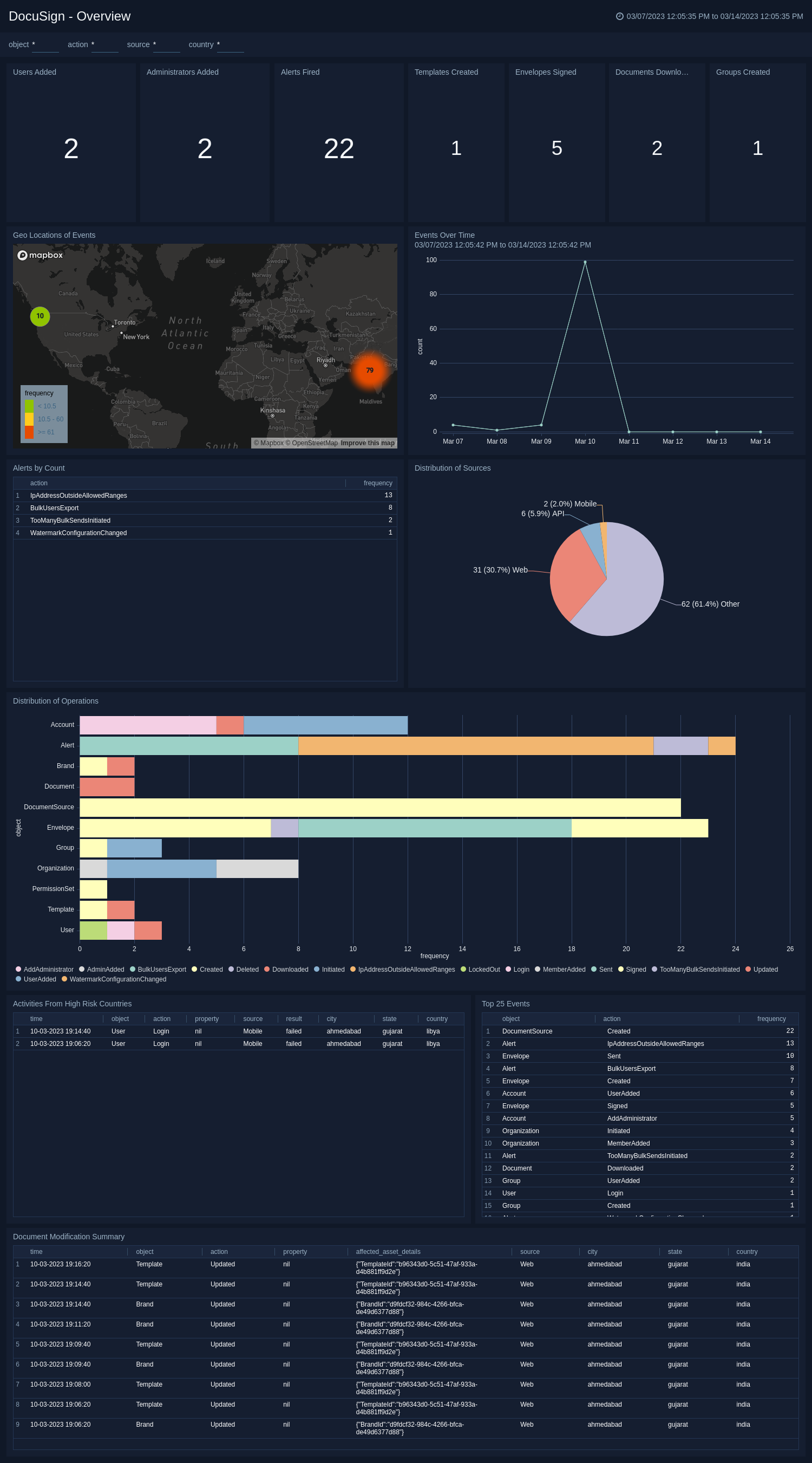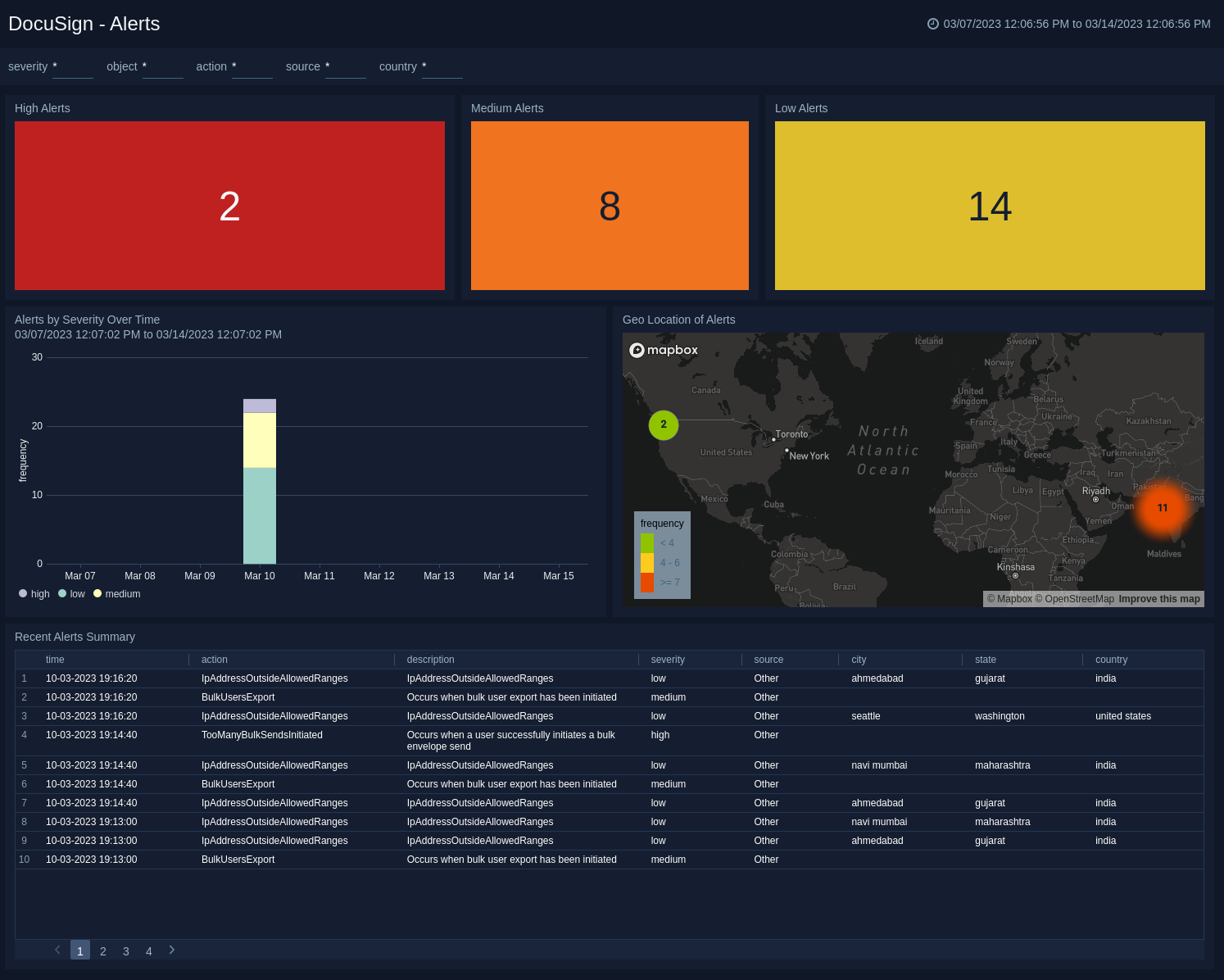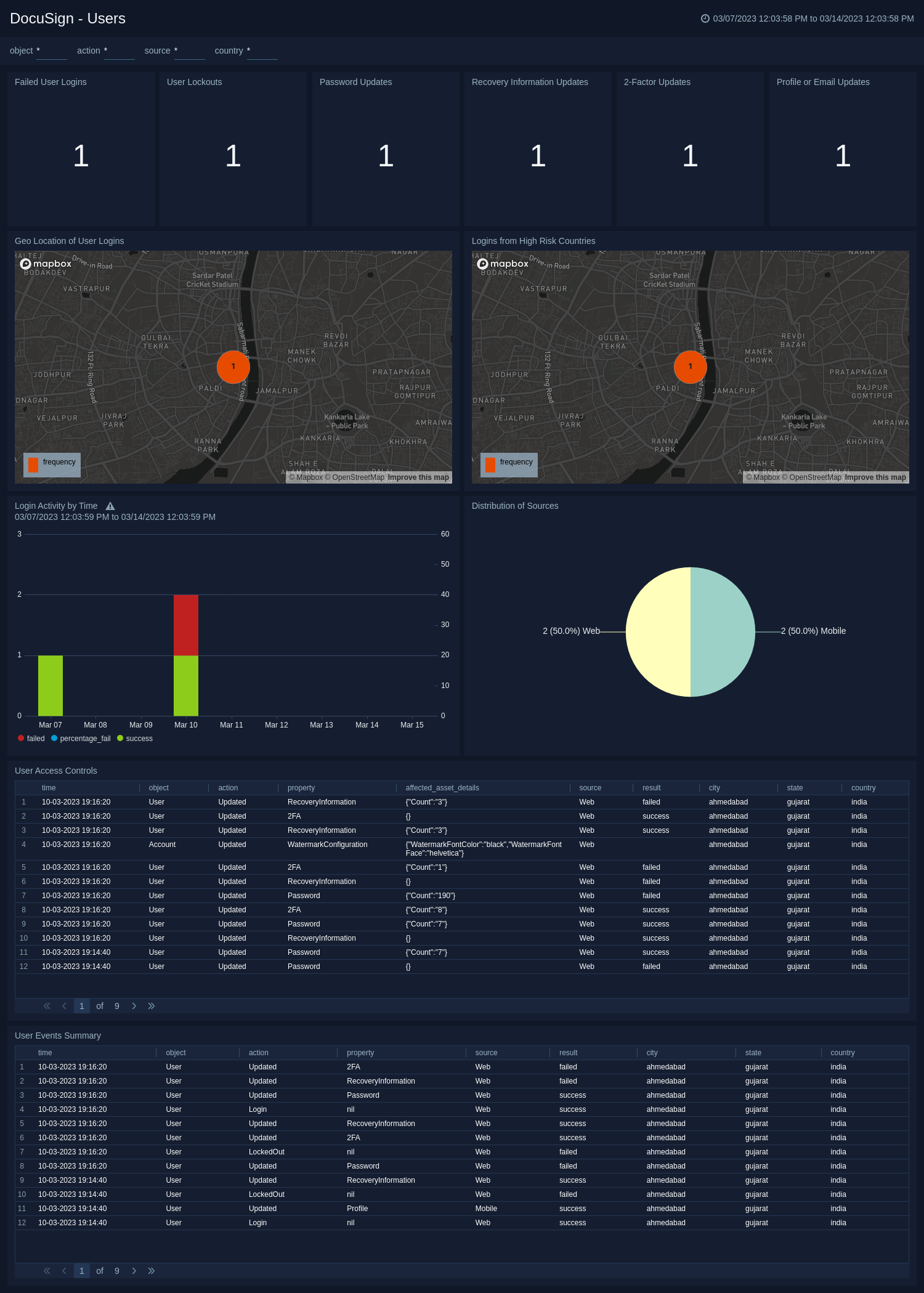DocuSign
The Sumo Logic app for DocuSign helps you monitor and secure your DocuSign account by providing real-time actionable insights into critical events, alerts, and user activity, allowing you to identify and address potential security threats before they can cause harm. With the DocuSign app, you can also protect data loss, identify suspicious activity, maintain the security of your DocuSign account, and prevent data breaches - all from a single, centralized platform.
The app leverages the DocuSign Monitor API to collect and analyze data from your DocuSign account, including document access and modification, user activity, authentication activity, and system events. You can set up custom alerts for critical events and user activity, and receive notifications in real-time when potential security threats are detected.
With the DocuSign app, you can:
- Monitor who accesses and changes important documents and detect any instances of unauthorized access or modifications to sensitive documents.
- Monitor user actions to identify any suspicious behavior, including attempts to access unauthorized data or engage in malicious activity.
- Monitor login activity to identify any abnormal or suspicious login attempts or unusual patterns of activity.
- Monitor system events for any signs of anomalies or potential security threats.
- Protect data loss by closely monitoring access, changes, and unauthorized activity.
- Analyze user behavior to identify potential security threats by looking for deviations from normal patterns of activity.
Log types
The DocuSign App for Sumo Logic uses Events and Alerts data to generate logs that can be used for monitoring and analysis.
Sample log messages
{
"timestamp":"2023-03-03T09:10:06.0512813Z",
"eventId":"a8010d32-b9f5-4948-9195-50c867d7c3a5",
"site":"DEMO",
"accountId":"8949bd2a-f1fc-4c95-ae8e-9e294b2af5b7",
"organizationId":"9e294b2af5b7-f1fc-4c95-8949bd2a",
"userId":"9cfb472b-ef1f-4116-8df2-17c53841fd6c",
"integratorKey":"##DOCUSIGN_INTERNAL_NOT_USED##",
"userAgent":"",
"ipAddress":"162.248.186.11",
"ipAddressLocation":{
"latitude":47.6,
"longitude":-122.33,
"country":"india",
"state":"gujarat",
"city":"akota"
},
"object":"Account",
"action":"UserAdded",
"property":"",
"field":"",
"result":"",
"source":"API",
"referencedUserId":"2020ac66-26b5-4367-aff3-f33bd9a007b7",
"proxyStatus":"",
"proxyType":"",
"proxyLevel":"",
"latitude":47.6,
"longitude":-122.33,
"city":"akota",
"state":"gujarat",
"country":"india",
"data":{
"AffectedUserId":"2020ac66-26b5-4367-aff3-f33bd9a007b7",
"AffectedMembershipId":"4da49358-8de5-4f62-9e9a-6029259723bc",
"PermissionProfileId":"14414475"
}
}
{
"timestamp":"2023-02-20T10:42:19.8996904Z",
"eventId":"285e7634-07fd-4877-ac12-b921d0e4b626",
"site":"DEMO",
"accountId":"",
"organizationId":"7f46f1ee-828e-41d4-9d85-755fa1814fd4",
"userId":"9cfb472b-ef1f-4116-8df2-17c53841fd6c",
"integratorKey":"",
"userAgent":"",
"ipAddress":"103.108.207.58",
"ipAddressLocation":{
"latitude":23.02,
"longitude":72.57,
"country":"india",
"state":"gujarat",
"city":"ahmedabad"
},
"object":"Alert",
"action":"IpAddressOutsideAllowedRanges",
"property":"",
"field":"",
"result":"",
"source":"Other",
"referencedUserId":"",
"proxyStatus":"",
"proxyType":"",
"proxyLevel":"",
"latitude":23.02,
"longitude":72.57,
"city":"ahmedabad",
"state":"gujarat",
"country":"india",
"data":{
"EventIds":[
"16b4a651-1e21-42a3-90ea-f5227224b591",
"1addc090-d227-4166-a279-dc6c5277247b",
"1e0f0d65-ab89-4b74-9f85-6f80b0cd59b4",
"205bb7fe-bada-4331-bfcb-73a81d0bebfd",
"260ff2b6-c818-409a-813b-91d4b5afee27",
"374f01a9-c86e-4600-b8e5-d20cd699fc65",
"3a28a286-b041-42e8-aaac-fdb8234951f1",
"3bc218bd-b8d6-4861-b471-f642c4b5aaca",
"40c2e748-bd09-45c9-958b-e89e3280f716",
"44badf68-6b7b-4294-b6bb-e1943dc0095b",
"88cd1d2f-87a5-49e5-92cf-39cdf9550be1",
"897bf5dc-2902-4270-a67e-dfd25fe98893",
"9cc9a7f1-a853-45ab-95c1-22c7e7834e1d",
"aaf22d31-9afa-48f3-880e-6287e4179daf",
"b4cc9614-6606-4fd9-86df-fad67b2f6181",
"de8ebe47-9e94-42e4-86db-4d56f882ab0a",
"e9e27037-213f-46db-9976-2b22c1b36bc9",
"f767e823-9722-49ef-8da5-b0d9f8dd13b6"
],
"Count":"18"
}
}
Sample queries
This section contains the sample queries of both the Events and Alerts.
_sourceCategory="docusign_src"
| json "object","userId","eventId","action","property","source","ipAddressLocation.latitude","ipAddressLocation.longitude","result","ipAddressLocation.city","ipAddressLocation.state","ipAddressLocation.country","data" as object,user_id,event_id,action,property,source,latitude,longitude,result,city,state,country,data nodrop
| where object matches "{{object}}" and action matches"{{action}}" and source matches"{{source}}"
| where country matches "{{country}}" or isNull(country)
| where object matches("*Account*") or object matches("*Connect*") or object matches("*User*") or object matches("*PermissionSet*")
| where action matches("*Updated*")
| count_distinct(event_id) by _messageTime,object,action,property,data,source,result,city,state,country
| formatDate(toLong(_messageTime), "dd-MM-yyyy HH:mm:ss") as time
| if(isBlank(property),"nil",property) as property
| top 100 time,object,action,property,data,source,result,city,state,country by time
_sourceCategory="docusign_src"
| json "object","userId","eventId","action","property","source","ipAddressLocation.latitude","ipAddressLocation.longitude","result","ipAddressLocation.city","ipAddressLocation.state","ipAddressLocation.country" as object,user_id,event_id,action,property,source,latitude,longitude,result,city,state,country nodrop
| where object matches "{{object}}" and action matches"{{action}}" and source matches"{{source}}"
| where country matches "{{country}}" or isNull(country)
| where object matches("*Alert*")
| lookup alert,object,ds_action,description,severity,severity_id from https://sumologic-app-data.s3.amazonaws.com/docusign_alert_lookup.csv on action = ds_action
| if(isNull(severity),"low",severity) as severity
| where severity matches "{{severity}}"
| timeslice 1d
| count_distinct(event_id) as frequency by _timeslice,severity
| fillmissing timeslice,values all in severity
| transpose row _timeslice column severity as low, medium, high
Collection configuration and app installation
Depending on the set up collection method, you can configure and install the app in three ways:
- Create a new collector and install the app. Create a new Sumo Logic Cloud-to-Cloud (C2C) source under a new Sumo Logic Collector and later install the app, or
- Use an existing collector and install the app. Create a new Sumo Logic Cloud-to-Cloud (C2C) source under an existing Sumo Logic Collector and later install the app, or
- Use existing source and install the app. Use your existing configured Sumo Logic Cloud-to-Cloud (C2C) source and install the app.
Use the Cloud-to-Cloud Integration for DocuSign to create the source and use the same source category while installing the app. By following these steps, you can ensure that your DocuSign app is properly integrated and configured to collect and analyze your DocuSign data.
Create a new collector and install the app
To set up collection and install the app, do the following:
Next-Gen App: To install or update the app, you must be an account administrator or a user with Manage Apps, Manage Monitors, Manage Fields, Manage Metric Rules, and Manage Collectors capabilities depending upon the different content types part of the app.
- Select App Catalog.
- In the 🔎 Search Apps field, run a search for your desired app, then select it.
- Click Install App.
note
Sometimes this button says Add Integration.
- In the Set Up Collection section of your respective app, select Create a new Collector.
- Collector Name. Enter a Name to display the Source in the Sumo Logic web application. The description is optional.
- Timezone. Set the default time zone when it is not extracted from the log timestamp. Time zone settings on Sources override a Collector time zone setting.
- (Optional) Metadata. Click the +Add Metadata link to add a custom log Metadata Fields. Define the fields you want to associate, each metadata field needs a name (key) and value.
 A green circle with a checkmark is shown when the field exists and is enabled in the Fields table schema.
A green circle with a checkmark is shown when the field exists and is enabled in the Fields table schema. An orange triangle with an exclamation point is shown when the field doesn't exist, or is disabled in the Fields table schema. In this case, you'll see an option to automatically add or enable the nonexistent fields to the Fields table schema. If a field is sent to Sumo Logic but isn’t present or enabled in the schema, it’s ignored and marked as Dropped.
An orange triangle with an exclamation point is shown when the field doesn't exist, or is disabled in the Fields table schema. In this case, you'll see an option to automatically add or enable the nonexistent fields to the Fields table schema. If a field is sent to Sumo Logic but isn’t present or enabled in the schema, it’s ignored and marked as Dropped.
- Click Next.
- Configure the source as specified in the
Infobox above, ensuring all required fields are included. - In the Configure section of your respective app, complete the following fields.
- Field Name. If you already have collectors and sources set up, select the configured metadata field name (eg _sourcecategory) or specify other custom metadata (eg: _collector) along with its metadata Field Value.
- Click Next. You will be redirected to the Preview & Done section.
Post-installation
Once your app is installed, it will appear in your Installed Apps folder, and dashboard panels will start to fill automatically.
Each panel slowly fills with data matching the time range query received since the panel was created. Results will not immediately be available but will be updated with full graphs and charts over time.
Use an existing collector and install the app
To set up the source in the existing collector and install the app, do the following:
Next-Gen App: To install or update the app, you must be an account administrator or a user with Manage Apps, Manage Monitors, Manage Fields, Manage Metric Rules, and Manage Collectors capabilities depending upon the different content types part of the app.
- Select App Catalog.
- In the 🔎 Search Apps field, run a search for your desired app, then select it.
- Click Install App.
note
Sometimes this button says Add Integration.
- In the Set Up Collection section of your respective app, select Use an existing Collector.
- From the Select Collector dropdown, select the collector that you want to set up your source with and click Next.
- Configure the source as specified in the
Infobox above, ensuring all required fields are included. - In the Configure section of your respective app, complete the following fields.
- Field Name. If you already have collectors and sources set up, select the configured metadata field name (eg _sourcecategory) or specify other custom metadata (eg: _collector) along with its metadata Field Value.
- Click Next. You will be redirected to the Preview & Done section.
Post-installation
Once your app is installed, it will appear in your Installed Apps folder, and dashboard panels will start to fill automatically.
Each panel slowly fills with data matching the time range query received since the panel was created. Results will not immediately be available but will be updated with full graphs and charts over time.
Use an existing source and install the app
To skip collection and only install the app, do the following:
Next-Gen App: To install or update the app, you must be an account administrator or a user with Manage Apps, Manage Monitors, Manage Fields, Manage Metric Rules, and Manage Collectors capabilities depending upon the different content types part of the app.
- Select App Catalog.
- In the 🔎 Search Apps field, run a search for your desired app, then select it.
- Click Install App.
note
Sometimes this button says Add Integration.
- In the Set Up Collection section of your respective app, select Skip this step and use existing source and click Next.
- In the Configure section of your respective app, complete the following fields.
- Field Name. If you already have collectors and sources set up, select the configured metadata field name (eg _sourcecategory) or specify other custom metadata (eg: _collector) along with its metadata Field Value.
- Click Next. You will be redirected to the Preview & Done section.
Post-installation
Once your app is installed, it will appear in your Installed Apps folder, and dashboard panels will start to fill automatically.
Each panel slowly fills with data matching the time range query received since the panel was created. Results will not immediately be available but will be updated with full graphs and charts over time.
Viewing DocuSign dashboards
All dashboards have a set of filters that you can apply to the entire dashboard. Use these filters to drill down and examine the data to a granular level.
- You can change the time range for a dashboard or panel by selecting a predefined interval from a drop-down list, choosing a recently used time range, or specifying custom dates and times. Learn more.
- You can use template variables to drill down and examine the data on a granular level. For more information, see Filtering Dashboards with Template Variables.
- Most Next-Gen apps allow you to provide the scope at the installation time and are comprised of a key (
_sourceCategoryby default) and a default value for this key. Based on your input, the app dashboards will be parameterized with a dashboard variable, allowing you to change the dataset queried by all panels. This eliminates the need to create multiple copies of the same dashboard with different queries.
Overview
The DocuSign - Overview dashboard gives you information about the records of recently added users and administrators. It gives insights regarding total alerts fired, new templates created, envelopes signed, documents downloaded, and new groups created in the organization. It also provides geo-location and trends of all the events. The app visualizes the distribution of all the operations happening in the organization.
In addition to the above, the app summarizes the most frequent events, alerts, sources, activities from high-risk countries, and document modifications. Overall, this dashboard offers comprehensive information about the team's activity and facilitates efficient monitoring of various important events.
Alerts
The DocuSign - Alerts dashboard keeps track of when some bulk action is performed or multiple login sessions from different locations happen. Also, it gives you insights about high, medium, and low alerts. It further summarizes all the alerts based on their severity over time.
Users
The DocuSign - Users dashboard gives you detailed information regarding the operations performed by the users of the organizations. It gives you the geo-locations of all the user logins and login activity from high-risk locations. Also, it gives visibility into user login activity and distribution of sources of user activity. Furthermore, it summarizes the critical updates in settings, roles, and permissions.
Upgrade/Downgrade the DocuSign app (Optional)
To update the app, do the following:
Next-Gen App: To install or update the app, you must be an account administrator or a user with Manage Apps, Manage Monitors, Manage Fields, Manage Metric Rules, and Manage Collectors capabilities depending upon the different content types part of the app.
- Select App Catalog.
- In the Search Apps field, search for and then select your app.
Optionally, you can identify apps that can be upgraded in the Upgrade available section. - To upgrade the app, select Upgrade from the Manage dropdown.
- If the upgrade does not have any configuration or property changes, you will be redirected to the Preview & Done section.
- If the upgrade has any configuration or property changes, you will be redirected to the Setup Data page.
- In the Configure section of your respective app, complete the following fields.
- Field Name. If you already have collectors and sources set up, select the configured metadata field name (eg _sourcecategory) or specify other custom metadata (eg: _collector) along with its metadata Field Value.
- Click Next. You will be redirected to the Preview & Done section.
Post-update
Your upgraded app will be installed in the Installed Apps folder and dashboard panels will start to fill automatically.
See our Release Notes changelog for new updates in the app.
To revert the app to a previous version, do the following:
- Select App Catalog.
- In the Search Apps field, search for and then select your app.
- To version down the app, select Revert to < previous version of your app > from the Manage dropdown.
Uninstalling the DocuSign app (Optional)
To uninstall the app, do the following:
- Select App Catalog.
- In the 🔎 Search Apps field, run a search for your desired app, then select it.
- Click Uninstall.